Young Children Discovering Multiliteracies
VerifiedAdded on 2022/08/25
|7
|1419
|28
AI Summary
Contribute Materials
Your contribution can guide someone’s learning journey. Share your
documents today.

Running head: YOUNG CHILDREN DISCOVERING MULTILITERACIES
YOUNG CHILDREN DISCOVERING MULTILITERACIES
Name of the Student
Name of the university
Author’s note
YOUNG CHILDREN DISCOVERING MULTILITERACIES
Name of the Student
Name of the university
Author’s note
Secure Best Marks with AI Grader
Need help grading? Try our AI Grader for instant feedback on your assignments.
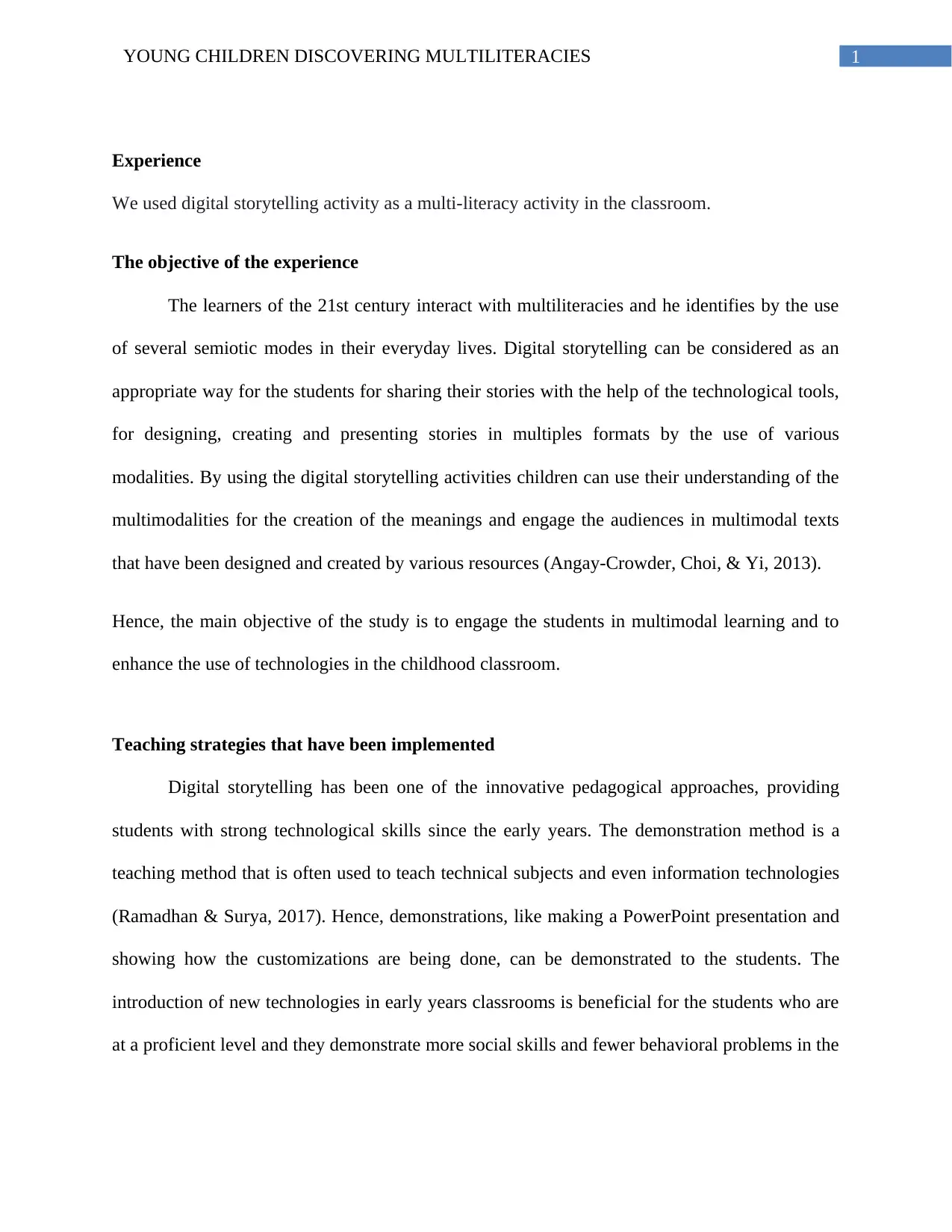
1YOUNG CHILDREN DISCOVERING MULTILITERACIES
Experience
We used digital storytelling activity as a multi-literacy activity in the classroom.
The objective of the experience
The learners of the 21st century interact with multiliteracies and he identifies by the use
of several semiotic modes in their everyday lives. Digital storytelling can be considered as an
appropriate way for the students for sharing their stories with the help of the technological tools,
for designing, creating and presenting stories in multiples formats by the use of various
modalities. By using the digital storytelling activities children can use their understanding of the
multimodalities for the creation of the meanings and engage the audiences in multimodal texts
that have been designed and created by various resources (Angay-Crowder, Choi, & Yi, 2013).
Hence, the main objective of the study is to engage the students in multimodal learning and to
enhance the use of technologies in the childhood classroom.
Teaching strategies that have been implemented
Digital storytelling has been one of the innovative pedagogical approaches, providing
students with strong technological skills since the early years. The demonstration method is a
teaching method that is often used to teach technical subjects and even information technologies
(Ramadhan & Surya, 2017). Hence, demonstrations, like making a PowerPoint presentation and
showing how the customizations are being done, can be demonstrated to the students. The
introduction of new technologies in early years classrooms is beneficial for the students who are
at a proficient level and they demonstrate more social skills and fewer behavioral problems in the
Experience
We used digital storytelling activity as a multi-literacy activity in the classroom.
The objective of the experience
The learners of the 21st century interact with multiliteracies and he identifies by the use
of several semiotic modes in their everyday lives. Digital storytelling can be considered as an
appropriate way for the students for sharing their stories with the help of the technological tools,
for designing, creating and presenting stories in multiples formats by the use of various
modalities. By using the digital storytelling activities children can use their understanding of the
multimodalities for the creation of the meanings and engage the audiences in multimodal texts
that have been designed and created by various resources (Angay-Crowder, Choi, & Yi, 2013).
Hence, the main objective of the study is to engage the students in multimodal learning and to
enhance the use of technologies in the childhood classroom.
Teaching strategies that have been implemented
Digital storytelling has been one of the innovative pedagogical approaches, providing
students with strong technological skills since the early years. The demonstration method is a
teaching method that is often used to teach technical subjects and even information technologies
(Ramadhan & Surya, 2017). Hence, demonstrations, like making a PowerPoint presentation and
showing how the customizations are being done, can be demonstrated to the students. The
introduction of new technologies in early years classrooms is beneficial for the students who are
at a proficient level and they demonstrate more social skills and fewer behavioral problems in the
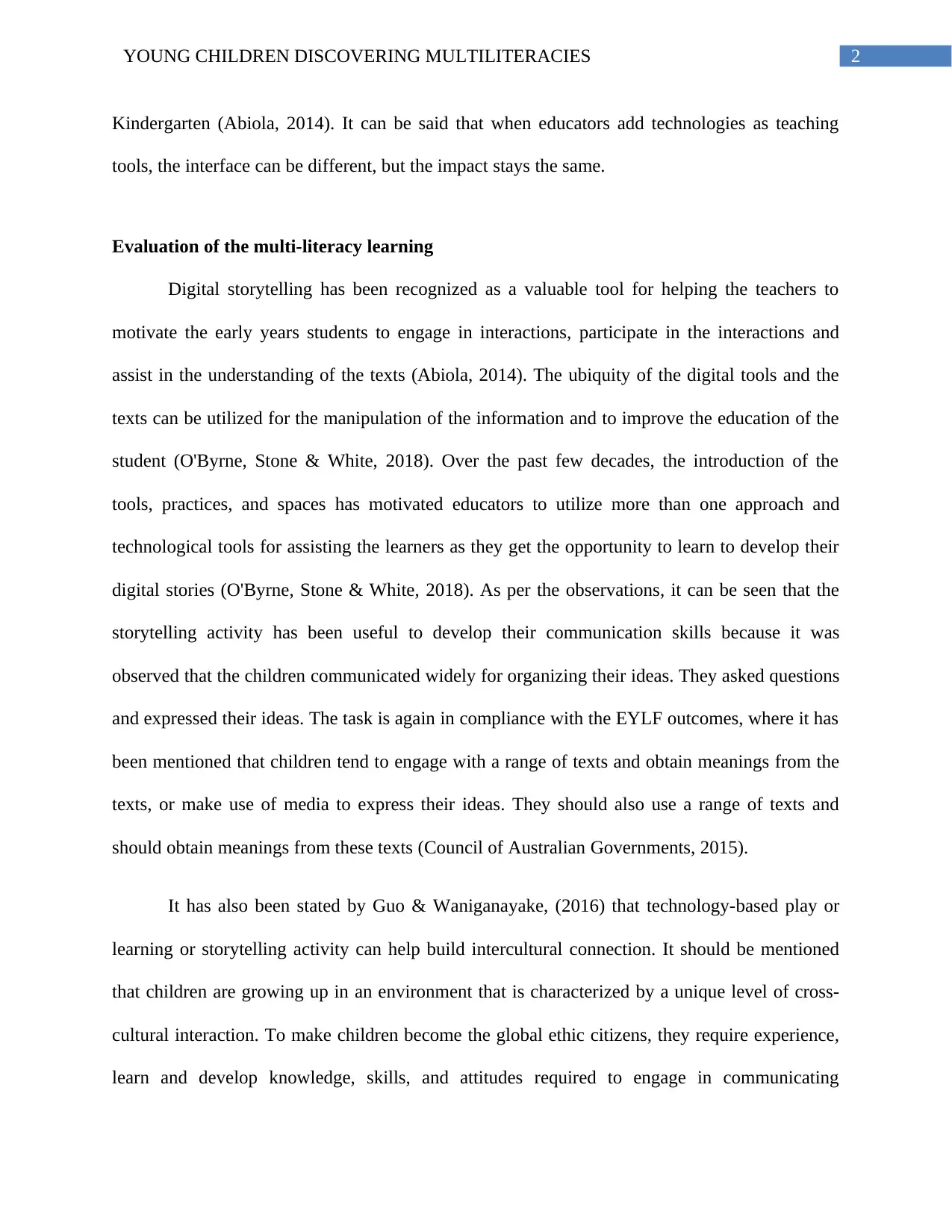
2YOUNG CHILDREN DISCOVERING MULTILITERACIES
Kindergarten (Abiola, 2014). It can be said that when educators add technologies as teaching
tools, the interface can be different, but the impact stays the same.
Evaluation of the multi-literacy learning
Digital storytelling has been recognized as a valuable tool for helping the teachers to
motivate the early years students to engage in interactions, participate in the interactions and
assist in the understanding of the texts (Abiola, 2014). The ubiquity of the digital tools and the
texts can be utilized for the manipulation of the information and to improve the education of the
student (O'Byrne, Stone & White, 2018). Over the past few decades, the introduction of the
tools, practices, and spaces has motivated educators to utilize more than one approach and
technological tools for assisting the learners as they get the opportunity to learn to develop their
digital stories (O'Byrne, Stone & White, 2018). As per the observations, it can be seen that the
storytelling activity has been useful to develop their communication skills because it was
observed that the children communicated widely for organizing their ideas. They asked questions
and expressed their ideas. The task is again in compliance with the EYLF outcomes, where it has
been mentioned that children tend to engage with a range of texts and obtain meanings from the
texts, or make use of media to express their ideas. They should also use a range of texts and
should obtain meanings from these texts (Council of Australian Governments, 2015).
It has also been stated by Guo & Waniganayake, (2016) that technology-based play or
learning or storytelling activity can help build intercultural connection. It should be mentioned
that children are growing up in an environment that is characterized by a unique level of cross-
cultural interaction. To make children become the global ethic citizens, they require experience,
learn and develop knowledge, skills, and attitudes required to engage in communicating
Kindergarten (Abiola, 2014). It can be said that when educators add technologies as teaching
tools, the interface can be different, but the impact stays the same.
Evaluation of the multi-literacy learning
Digital storytelling has been recognized as a valuable tool for helping the teachers to
motivate the early years students to engage in interactions, participate in the interactions and
assist in the understanding of the texts (Abiola, 2014). The ubiquity of the digital tools and the
texts can be utilized for the manipulation of the information and to improve the education of the
student (O'Byrne, Stone & White, 2018). Over the past few decades, the introduction of the
tools, practices, and spaces has motivated educators to utilize more than one approach and
technological tools for assisting the learners as they get the opportunity to learn to develop their
digital stories (O'Byrne, Stone & White, 2018). As per the observations, it can be seen that the
storytelling activity has been useful to develop their communication skills because it was
observed that the children communicated widely for organizing their ideas. They asked questions
and expressed their ideas. The task is again in compliance with the EYLF outcomes, where it has
been mentioned that children tend to engage with a range of texts and obtain meanings from the
texts, or make use of media to express their ideas. They should also use a range of texts and
should obtain meanings from these texts (Council of Australian Governments, 2015).
It has also been stated by Guo & Waniganayake, (2016) that technology-based play or
learning or storytelling activity can help build intercultural connection. It should be mentioned
that children are growing up in an environment that is characterized by a unique level of cross-
cultural interaction. To make children become the global ethic citizens, they require experience,
learn and develop knowledge, skills, and attitudes required to engage in communicating

3YOUNG CHILDREN DISCOVERING MULTILITERACIES
effectively with other children suffering from a diverse background (Guo & Waniganayake,
2016). It should be mentioned, that the storytelling activity that has been done or the story that
has been chosen has been age-appropriate (4-5 years). Again, children who were reading out the
narrations had been asked to practice speed reading for several times, which further enhanced the
speed reading skills.
Discussing the role of the educator in digital storytelling, It is necessary to scaffold the
use of languages while storytelling. One of the importance of adult scaffolding is to monitor the
language of the students for making sure that it is used at the time of the activities. Adult
scaffolding is required to teach the voice modulations at the time of narration (Leong & Bodrova,
2012). Scaffolding the scenarios of digital storytelling can be made up of several components.
For example, children often lack the background knowledge of the stories. It is necessary to have
a clear concept of the story before reading out the story or to develop a storyboard.
Two ways, the learning could be extended
Extended learning can be helpful for children as they increase motivation in children,
provide specialist support to children with additional needs. It tends to improve the capability of
working in partnership, with the community. Benefits for the families involve improvements in
the behavior of the child.
This learning experience can be extended by conducting similar activities at home. Children can
be asked to develop a storyboard based on their family, where they will take help from their
parents to develop such storytelling activities at home (Vivitsou et al., 2018).
effectively with other children suffering from a diverse background (Guo & Waniganayake,
2016). It should be mentioned, that the storytelling activity that has been done or the story that
has been chosen has been age-appropriate (4-5 years). Again, children who were reading out the
narrations had been asked to practice speed reading for several times, which further enhanced the
speed reading skills.
Discussing the role of the educator in digital storytelling, It is necessary to scaffold the
use of languages while storytelling. One of the importance of adult scaffolding is to monitor the
language of the students for making sure that it is used at the time of the activities. Adult
scaffolding is required to teach the voice modulations at the time of narration (Leong & Bodrova,
2012). Scaffolding the scenarios of digital storytelling can be made up of several components.
For example, children often lack the background knowledge of the stories. It is necessary to have
a clear concept of the story before reading out the story or to develop a storyboard.
Two ways, the learning could be extended
Extended learning can be helpful for children as they increase motivation in children,
provide specialist support to children with additional needs. It tends to improve the capability of
working in partnership, with the community. Benefits for the families involve improvements in
the behavior of the child.
This learning experience can be extended by conducting similar activities at home. Children can
be asked to develop a storyboard based on their family, where they will take help from their
parents to develop such storytelling activities at home (Vivitsou et al., 2018).
Secure Best Marks with AI Grader
Need help grading? Try our AI Grader for instant feedback on your assignments.
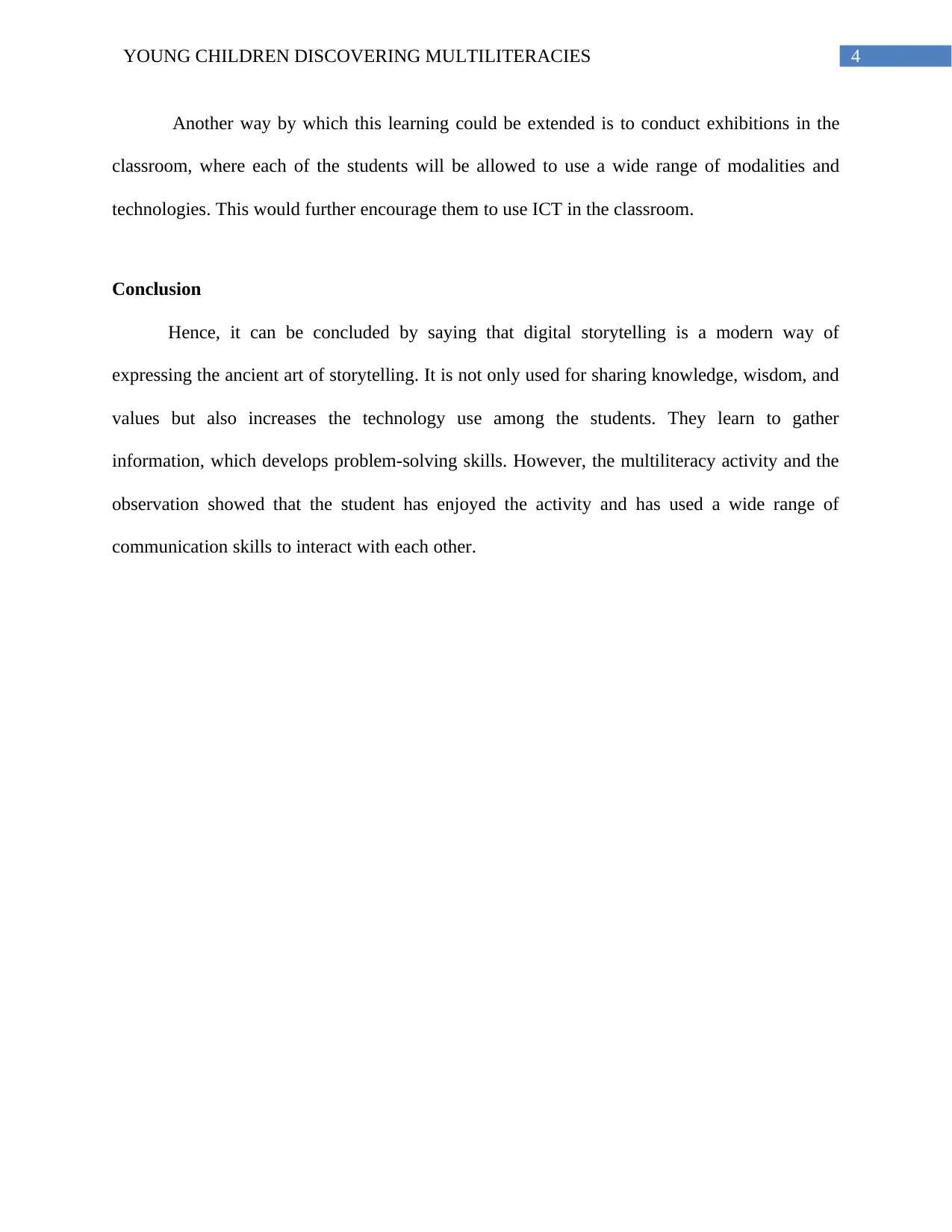
4YOUNG CHILDREN DISCOVERING MULTILITERACIES
Another way by which this learning could be extended is to conduct exhibitions in the
classroom, where each of the students will be allowed to use a wide range of modalities and
technologies. This would further encourage them to use ICT in the classroom.
Conclusion
Hence, it can be concluded by saying that digital storytelling is a modern way of
expressing the ancient art of storytelling. It is not only used for sharing knowledge, wisdom, and
values but also increases the technology use among the students. They learn to gather
information, which develops problem-solving skills. However, the multiliteracy activity and the
observation showed that the student has enjoyed the activity and has used a wide range of
communication skills to interact with each other.
Another way by which this learning could be extended is to conduct exhibitions in the
classroom, where each of the students will be allowed to use a wide range of modalities and
technologies. This would further encourage them to use ICT in the classroom.
Conclusion
Hence, it can be concluded by saying that digital storytelling is a modern way of
expressing the ancient art of storytelling. It is not only used for sharing knowledge, wisdom, and
values but also increases the technology use among the students. They learn to gather
information, which develops problem-solving skills. However, the multiliteracy activity and the
observation showed that the student has enjoyed the activity and has used a wide range of
communication skills to interact with each other.
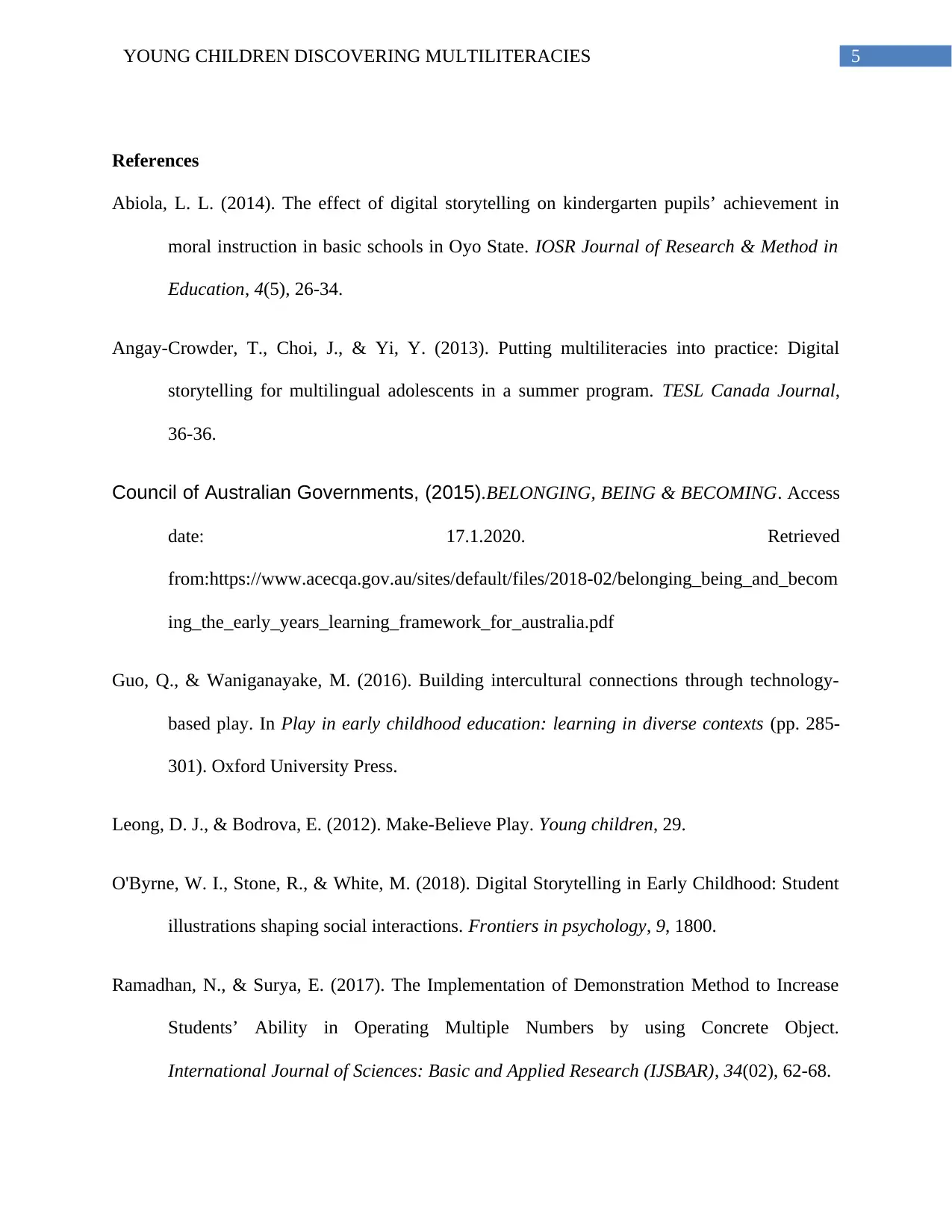
5YOUNG CHILDREN DISCOVERING MULTILITERACIES
References
Abiola, L. L. (2014). The effect of digital storytelling on kindergarten pupils’ achievement in
moral instruction in basic schools in Oyo State. IOSR Journal of Research & Method in
Education, 4(5), 26-34.
Angay-Crowder, T., Choi, J., & Yi, Y. (2013). Putting multiliteracies into practice: Digital
storytelling for multilingual adolescents in a summer program. TESL Canada Journal,
36-36.
Council of Australian Governments, (2015).BELONGING, BEING & BECOMING. Access
date: 17.1.2020. Retrieved
from:https://www.acecqa.gov.au/sites/default/files/2018-02/belonging_being_and_becom
ing_the_early_years_learning_framework_for_australia.pdf
Guo, Q., & Waniganayake, M. (2016). Building intercultural connections through technology-
based play. In Play in early childhood education: learning in diverse contexts (pp. 285-
301). Oxford University Press.
Leong, D. J., & Bodrova, E. (2012). Make-Believe Play. Young children, 29.
O'Byrne, W. I., Stone, R., & White, M. (2018). Digital Storytelling in Early Childhood: Student
illustrations shaping social interactions. Frontiers in psychology, 9, 1800.
Ramadhan, N., & Surya, E. (2017). The Implementation of Demonstration Method to Increase
Students’ Ability in Operating Multiple Numbers by using Concrete Object.
International Journal of Sciences: Basic and Applied Research (IJSBAR), 34(02), 62-68.
References
Abiola, L. L. (2014). The effect of digital storytelling on kindergarten pupils’ achievement in
moral instruction in basic schools in Oyo State. IOSR Journal of Research & Method in
Education, 4(5), 26-34.
Angay-Crowder, T., Choi, J., & Yi, Y. (2013). Putting multiliteracies into practice: Digital
storytelling for multilingual adolescents in a summer program. TESL Canada Journal,
36-36.
Council of Australian Governments, (2015).BELONGING, BEING & BECOMING. Access
date: 17.1.2020. Retrieved
from:https://www.acecqa.gov.au/sites/default/files/2018-02/belonging_being_and_becom
ing_the_early_years_learning_framework_for_australia.pdf
Guo, Q., & Waniganayake, M. (2016). Building intercultural connections through technology-
based play. In Play in early childhood education: learning in diverse contexts (pp. 285-
301). Oxford University Press.
Leong, D. J., & Bodrova, E. (2012). Make-Believe Play. Young children, 29.
O'Byrne, W. I., Stone, R., & White, M. (2018). Digital Storytelling in Early Childhood: Student
illustrations shaping social interactions. Frontiers in psychology, 9, 1800.
Ramadhan, N., & Surya, E. (2017). The Implementation of Demonstration Method to Increase
Students’ Ability in Operating Multiple Numbers by using Concrete Object.
International Journal of Sciences: Basic and Applied Research (IJSBAR), 34(02), 62-68.
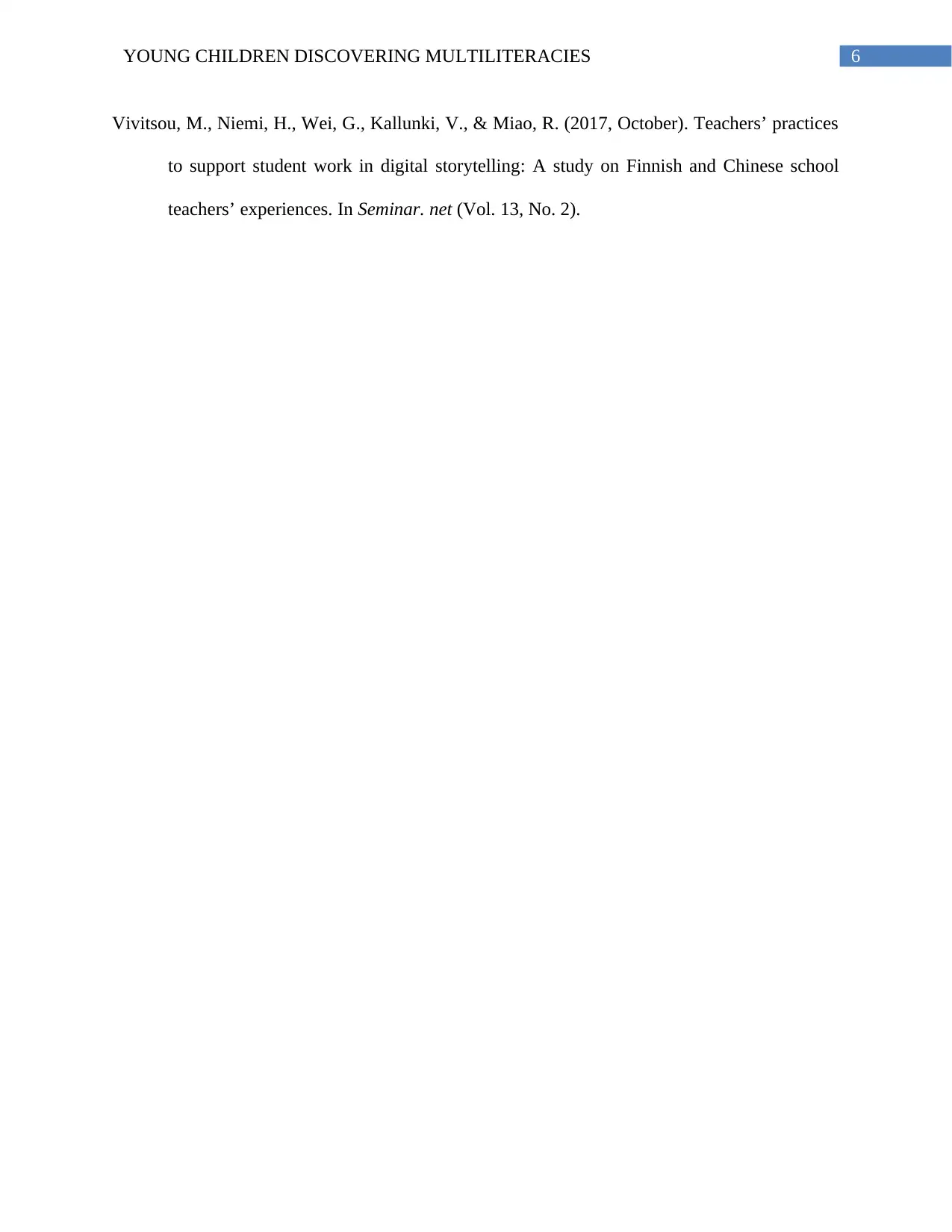
6YOUNG CHILDREN DISCOVERING MULTILITERACIES
Vivitsou, M., Niemi, H., Wei, G., Kallunki, V., & Miao, R. (2017, October). Teachers’ practices
to support student work in digital storytelling: A study on Finnish and Chinese school
teachers’ experiences. In Seminar. net (Vol. 13, No. 2).
Vivitsou, M., Niemi, H., Wei, G., Kallunki, V., & Miao, R. (2017, October). Teachers’ practices
to support student work in digital storytelling: A study on Finnish and Chinese school
teachers’ experiences. In Seminar. net (Vol. 13, No. 2).
1 out of 7
![[object Object]](/_next/static/media/star-bottom.7253800d.svg)





